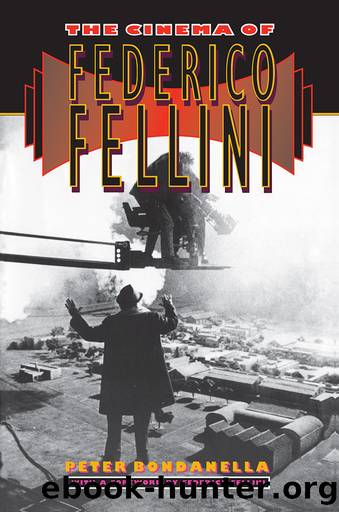The Cinema of Federico Fellini by Peter Bondanella

Author:Peter Bondanella
Language: eng
Format: epub
Publisher: Princeton University Press
Published: 2020-01-15T00:00:00+00:00
24. I clowns: a young boy recalling the comic strip "Little Nemo" sees the circus for the first time
Fellini has defined the clown as an expression of "the irrational aspect of man; he stands for the instinct, for whatever is rebellious in each one of us and whatever stands up to the established order of things. He is a caricature of man's childish and animal aspects, the mocker and the mocked. The clown is a mirror in which man sees himself in a grotesque, deformed, ridiculous image. He is man's shadow."59 Fellini divides clowns into two comic types: the Auguste clown, the eternal rebel, drunkard, adolescent misfit; and the authoritarian white clown who is the Auguste's constant companion. As Fellini puts it, "they are two psychological aspects of man: one which aims upwards, the other which aims downwards; two divided, separated instincts."60 This same division can be found in the most famous Hollywood comedy teams, such as Laurel and Hardy, Martin and Lewis, Burns and Allen, Harpo and Groucho Marx, Abbot and Costello. The two kinds of clowns also function rather well as psychological profiles of two immediately recognizable kinds of human personalities: the white clown stresses duty and authority and generally represses his natural instincts; on the other hand, the Auguste clown remains free of repressive guilt and constantly breaks all the conventional rules of behavior, just like the children who immediately identify with him.
Fellini's view of the clown not only explains the dynamics of circus acts but also has applications to human personality outside the circus ring. The opening scenes of the clown acts viewed through the perspective of Fellini's adolescence establish a simple pattern of clowning: clown acts usually imitate or parody other, more traditional, circus acts in a grotesque fashion. Thus, the strongman act of Robor, who balances a canon on his back catapulted there by another strongman, is immediately parodied by two clowns, one of whom catapults a lighted cigar into the other's mouth. A knife-thrower's act is immediately caricatured by a midget clown, who plants a hatchet into the head of his colleague, and so on. The film's opening sequences thus establish the fact that one of the clown's key features is his inevitable parody of the "reality" around him. But the various characters the young Fellini views for the first time in the circus ring have another metacinematic dimension as well, for they also recall themes or characters in films produced by the adult director: the two gigantic female wrestlers, Miss Matilde and Miss Tarzan, cannot help but remind us of La Saraghina in 8 1/2 (especially as the Wagnerian music employed in that film accompanies them here); the ringmaster's warning before Robor's performance that those in the audience without strong hearts should take care seems taken directly from Zampanò's routine in La strada-, in the final procession that closes this section of the film, the famous music of the finale of 8 1/2 by Nino Rota can be heard. While the initial
Download
This site does not store any files on its server. We only index and link to content provided by other sites. Please contact the content providers to delete copyright contents if any and email us, we'll remove relevant links or contents immediately.
| Coloring Books for Grown-Ups | Humor |
| Movies | Performing Arts |
| Pop Culture | Puzzles & Games |
| Radio | Sheet Music & Scores |
| Television | Trivia & Fun Facts |
The Kite Runner by Khaled Hosseini(5061)
Gerald's Game by Stephen King(4556)
Dialogue by Robert McKee(4305)
The Perils of Being Moderately Famous by Soha Ali Khan(4156)
The 101 Dalmatians by Dodie Smith(3440)
Story: Substance, Structure, Style and the Principles of Screenwriting by Robert McKee(3384)
The Pixar Touch by David A. Price(3344)
Confessions of a Video Vixen by Karrine Steffans(3230)
How Music Works by David Byrne(3157)
Fantastic Beasts: The Crimes of Grindelwald by J. K. Rowling(2975)
Harry Potter 4 - Harry Potter and The Goblet of Fire by J.K.Rowling(2974)
Slugfest by Reed Tucker(2923)
The Mental Game of Writing: How to Overcome Obstacles, Stay Creative and Productive, and Free Your Mind for Success by James Scott Bell(2835)
4 - Harry Potter and the Goblet of Fire by J.K. Rowling(2639)
Screenplay: The Foundations of Screenwriting by Syd Field(2561)
The Complete H. P. Lovecraft Reader by H.P. Lovecraft(2499)
Scandals of Classic Hollywood: Sex, Deviance, and Drama from the Golden Age of American Cinema by Anne Helen Petersen(2453)
Wildflower by Drew Barrymore(2431)
Robin by Dave Itzkoff(2368)
